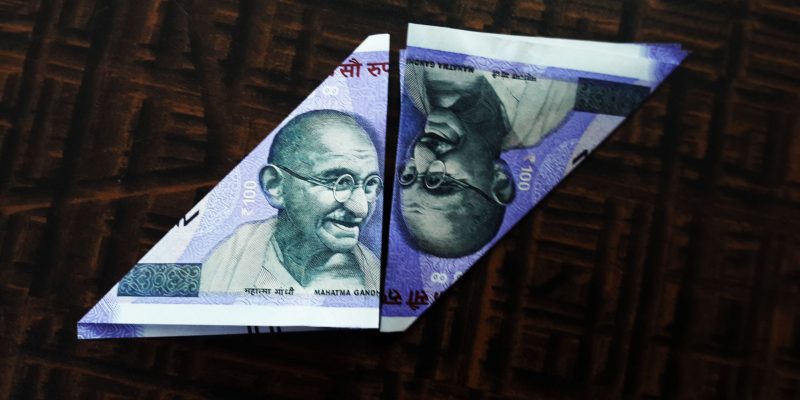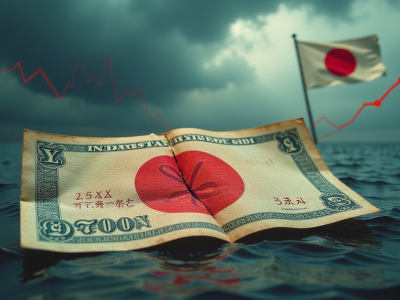
The Indian rupee (INR) is rapidly gaining favor among global investors for carry trade, a financial strategy that benefits from currency stability and favorable interest rates.
With India’s economic ascent and the rupee’s increasing popularity, global traders are looking to capitalize on its low volatility and relatively stable performance.
Joe Brusuelas, chief economist at RSM US said in a note on Monday,
“India has the fifth-largest stock market, and its $1.3 trillion sovereign debt market is the darling of global and institutional investors looking for solid fixed-income returns—they are using its stable currency, the rupee, as the source of a lucrative carry trade across the $7.5 trillion per day churn in global capital markets.”
INR-USD pair replacing JPY-USD carry trade?
The carry trade strategy involves borrowing in a low-interest-rate currency and investing the funds in another currency for higher returns.
Historically, the yen-dollar carry trade has been one of the most popular strategies. However, investors are increasingly shifting focus to the rupee-dollar bilateral pair due to its favorable risk-return profile.
Starting the year at 82.35 against the dollar, the rupee fell only modestly to 83.9 in early August.
“India’s rupee has become the cornerstone of a global carry trade,” says Brusuelas.
Low volatility makes INR a standout
In Asia, the Indian rupee has emerged as the only currency to deliver positive returns against the US dollar in 2023, according to Bloomberg.
This sets it apart from other regional currencies that have been more volatile or underperformed in carry trade strategies.
While the rupee may not offer the high yields of currencies like the Mexican peso or Turkish lira, it presents a far lower risk of a significant correction, David Hauner, head of global EM fixed-income strategy at Bank of America said in a Bloomberg interview in June.
Further, the one-month implied volatility of the rupee-dollar exchange rate, at 3.55, signals a lower expected volatility compared to other regional currencies like the Chinese yuan, Thai baht, and South Korean won, Brusuelas said.
Source: RSM US
RBI’s role in keeping INR strong
Rupee’s minimal volatility is attributed to the Reserve Bank of India (RBI) maintaining long-term interest rate pauses and building record foreign exchange reserves.
In an interview with Invezz in July, FX strategist and economist at ANZ Research, Dhiraj Nim pointed out that the rupee’s stability was not natural, but “engineered”.
Nim said behind the currency’s stability was the two-way intervention of the RBI in both FX absorption as well as sales, supplementing the effect of India’s strong fundamentals in a big way.
“This has allowed the RBI to amass large FX reserves, improving external stability metrics, and ensure rupee’s competitiveness especially when inflows have picked up,” he said.
In an interview with CNBC in April, Paul Greer, a money manager at Fidelity in London, said,
“When I look at the Indian rupee, I don’t think about it as an appreciation trade. Because RBI has been so tight on both sides of the range, the carry-to-volatility ratio is what many investors are attracted to.”
Forecast for INR
As India’s economy continues to expand and shift toward providing global economic services rather than traditional manufacturing, the demand for rupee-denominated assets is expected to rise.
JP Morgan’s inclusion of Indian fixed-income assets in its emerging market global bond index will likely further stimulate investor interest in rupee assets.
Forward pricing as of Aug. 23 implies the rupee will flatten out through the end of the year before depreciating further to 95.6 over the next five years.
Such a move would mean a 14% depreciation in the value of the rupee at a pace of 2.6% per year, Brusuelas said.
As long as the RBI remains committed to intervening in currency markets to stabilize the rupee, investors will continue to use the rupee as the basis of a global carry trade that bolsters dollar-denominated assets in the US and other economies, he said.
However, as the rupee’s popularity grows among carry traders, some caution is emerging regarding potential overcrowding in the market.
Despite this, the currency’s carry attractiveness remains strong, particularly when paired with short positions in the euro or Chinese yuan, according to analysts at Goldman Sachs.
The post Indian rupee gains traction in global carry trade as investors seek stability appeared first on Invezz












